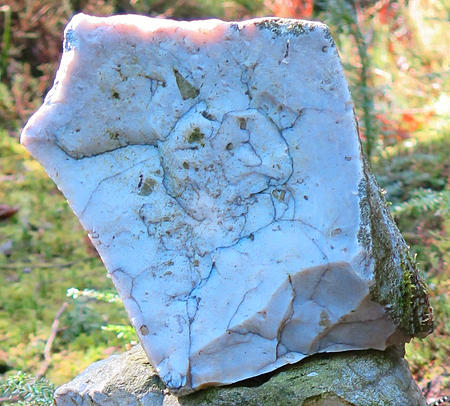>> | Home | Books | Visit | Explore & More | Events | FAQs | Contacts
Hemyock Castle
Ancient Heart of the Blackdowns
Deep Historic Links with Continental Europe
These webpages use pottery sherds (fragments) & objects found at Hemyock Castle, to explore centuries of close links with continental Europe: Links to other webpages in this series.
Stone Age: Prehistoric Blackdown Flint Stone Export Trade with Europe
Everyone in the British Isles, has arrived from somewhere else: During the last Ice Age, most of northern Europe and the British Isles were uninhabitable. 18,000 years ago, the thick glacial ice sheet stretched as far south as the Bristol Channel. The first humans started exploring perhaps 3 or 4 thousand years later; by about 11,700 years ago, as the climate warmed and the ice sheet retreated, human settlements became more widespread. Subsequently, waves of new peoples arrived to settle the land.
This prehistoric period is explored further in the new Making Connections Exhibition, at Stonehenge, created by English Heritage and the British Museum.

Blackdown Flint Stone, Near Culm Davy
During the Stone Age, flint stones extracted from the Blackdown Hills around Hemyock were traded with the peoples of continental Europe, for manufacture into stone tools. They must have been taken by boat; presumably from Devon's coast. Decorative glass beads were amongst the articles obtained in return.
Trade has evolved: Both official and unofficial trade have continued ever since; often involving local people on both sides of the English Channel.
Other webpages in this series, exploring centuries of close links with continental Europe:
- Introduction: Deep Historic Links
- Blackdown Flints
- Romano-British Iron Slag
- Rouen Pottery
- France & Portugal
- Spain & Italy
- Future King
- Bartmann / Bellarmine Pots
- Blackdown Whetstones
European Year of Cultural Heritage – UK is the UK's part of The European Year of Cultural Heritage, a new European initiative.
- The European Year of Cultural Heritage 2018
- Hemyock Castle: Heritage Open Days
- Tour of Hemyock Castle
- A Glimpse of the Interpretation Centre
- Return to Hemyock Castle
Home | Books | Visit | Explore & More | Events | FAQs | Contacts
Hemyock Castle, Hemyock, CULLOMPTON, Devon, EX15 3RJ, UK.
© 2001–2021. Prepared and published by Curlew Communications Ltd